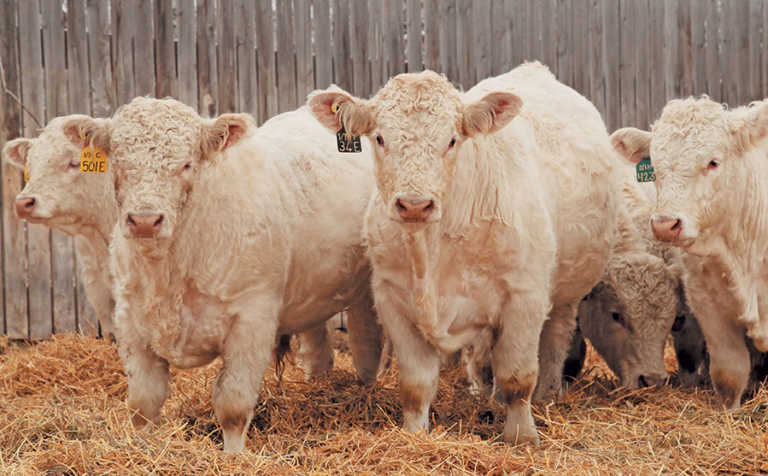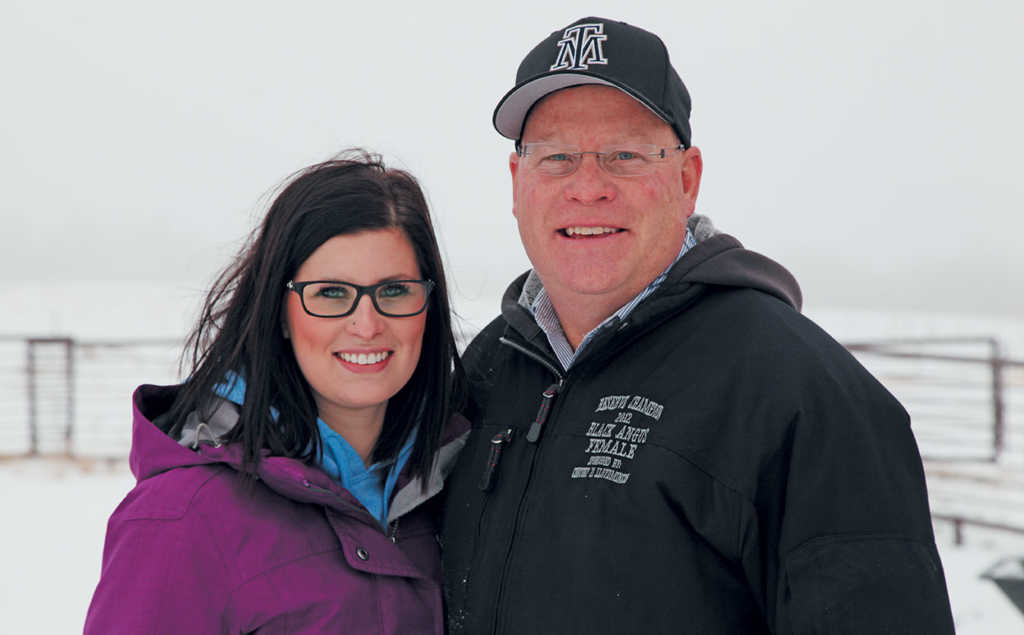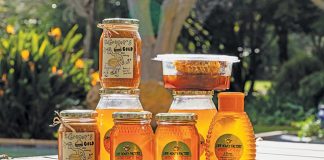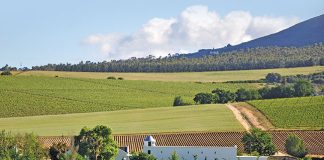
Photo: Gerhard Uys
Father-and-daughter team Greg and Kelsey Knot, of the farm 4K Land and Cattle Co. in Ardrossan, Alberta, Canada, run a small Red and Black Angus herd of about 40 cows.
Seven of these are stud animals, and the remainder are commercial. Although the operation is small, it contributes to the genetic base of commercial breeders in Canada, and is a reflection of a large and productive part of the the country’s cattle industry.
READ Canada’s livestock industry in pictures
Most of these herds are run by farmers who have full-time, off-farm jobs.
Kelsey, for example, is an agricultural specialist at an accounting firm, and takes care of her stud animals in her free time.
A similar pattern is evident on two other farms in the district. A short drive away, Barrie Przekop and his daughter, Dacie, run about 100 red and black Simmentaler stud cows on their farm, Lake Bottom Cattle Co.
They also have a small number of commercial cattle. Barrie has a full-time job on the oil fields, but works there only every alternate week, giving him time to look after his cattle. Dacie manages the cattle full time.
On the Kay-R Charolais Ranch in Waskatenau, Kasey and Arlana Phillips, their son, Kord, and Kasey’s father, Clinton, run a slightly larger herd of 150 head of Charolais, of which 120 are stud animals.

This farm is different to the other two in that the family has planted 2 600ha to malting barley, wheat for ethanol production, and canola, and they farm full time.
All three families show their stud animals.
Coping with the cold
Amongst the greatest challenges these farmers face is the cold. Temperatures in the area can reach above 30˚C in summer, with an average temperature of 22˚C.
In winter, however, cold snaps, which can last up to three days, can cause temperatures to plummet well below -40˚C with the wind chill factor. Winter temperatures average -15˚C.
This extreme cold is challenging, and one such challenge is keeping the water from freezing. On the Knots farm, water is drawn from a borehole 2,4m deep.
The natural heat of the soil prevents the water from freezing, but once exposed to the outside air, the water freezes instantly. To solve this problem, the water is piped into a heated, insulated container that keeps it fluid, even on days with temperatures of -40˚C.
Health
While the cold presents difficulties, it also provides livestock with some health benefits. For example, parasites, such as ticks, cannot survive in these conditions, and are therefore a relatively small problem for these farmers.
However, humidity is problematic, and while producers generally follow standard vaccination programmes, they have to work particularly hard to manage the challenges associated with humidity. One such problem is lung issues that may arise from the humidity when cattle are kept in barns for too long.
Kasey says that health management is his main challenge, with pneumonia his chief concern. While he keeps his cows in barns during calving, he moves them out a day after.
However, portable shelters are used to protect the calves from the worst cold.
According to Kelsey, E.coli can become a problem when rain and snow combine, especially during calving.
The Knots also vaccinate against black leg, a clostridium disease found in soils in the region. These bacteria can survive extreme temperatures, and wounds on cattle or other animals provide the ideal conditions for these bacteria to reproduce.
Once in the animal’s bloodstream, they produce toxins that can kill within hours. Kelsey says that moving cows out to pasture and onto either dry ground or straw helps prevent many types of infections, particularly black leg.
Grazing and feed
The Knots run cattle on 48ha, and lease out 194ha to grain producers. Most of the veld on their farm comprises the palatable Timothy bromegrass, which contains sufficiently high levels of protein that keep their cattle in good condition.
Some lucerne-type grasses also occur naturally. In winter, the cattle push the snow aside with their snouts and feed on the grass under the snow, but Greg and Kelsey supplement their cattle with hay throughout winter.
On the Phillipses’ farm, cattle graze natural veld in summer, and feed on hay and barley silage in winter.
“On our pastures, we need about 1,6ha to sustain a cow/ calf pair for the summer. There’s a lot of grass while summer lasts. We have about 120 frost-free days a year,” says Kasey.
For the remainder of the year, the Phillips family relies on swathe grazing, barley silage and hay. (Swathe grazing is similar to standing hay, but the grass is cut before winter and allowed to fall over).
While the carrying capacity of swathe grazing depends on the grass, 16ha in a good year could feed 120 cows for 50 days. Cattle are rotated to new camps every two weeks.
“This year, however, we had above-average rainfall and below-average sun units. So 120 cows consumed the swathe grazing in two weeks as the grass was wet and of lower quality,” explains Kasey.
“Once the grass is chewed halfway, we move the cattle. We start at 20cm to 25cm. Our biggest problem is keeping ahead because it grows so fast [longer grass has less protein]. We have Timothy bromegrass and alfalfa-type grasses.”
In Canada, natural grasses are either not sold or are very expensive, unlike in South Africa, where veld grasses such as Smuts finger are sold commercially.
Pastures on the Phillipses’ farm are selected to suit the soils, but with the area’s No. 2 black loam soil type, the family has little trouble growing grass or crops.
At Lake Bottom Cattle, Barrie and Dacie run their 100-strong herd on about 161ha.
“This used to be the bed of a lake. The grass grows plentifully,” Barrie says.
While the grasses on this farm are not very high in nutritional value, the cattle select the best stalks while grazing.
They are also fed hay made from the same grass, as well as barley silage mixed by a contractor.
Breeding and calving
On the Knots’ farm, the cows are taken to barns only when they calve mid-winter between January and March.
Although it may seem unproductive to plan calving for when forage protein is at its lowest, this is done so that the calves can be weaned in October before it gets too cold.
It also helps calves adapt to the extreme cold so they can survive without the assistance of their dams. Moreover, it also allows cows to recover so they can conceive again.
On the Phillipses’ farm, calving time is market-driven.
“If we calved with the environment, we’d do so in May. But we don’t have time because we’re also planting in May. So we calve between January and March, the coldest time of the year,” explains Kasey.
The Phillips family could, of course, hire labour to manage calving during the optimal calving time, but this would be expensive, as the family currently employs only one full-time farmworker. The farmworker, along with the five family members, manage the 2 600ha of crops and the cattle.
At peak times, additional workers are contracted, but Kasey finds it difficult to find employees, as he can afford to pay only C$20/h (R219/h), whereas labourers can earn double this on the oil fields.
On the Przekop farm, Dacie has been trained to perform artificial insemination (AI), and handles this aspect of breeding at Lake Bottom Cattle. After AI, bulls are still used to service the cows in March, at the beginning of spring.
“We put [only] one bull with 20 cows. We learnt the hard way when a bull got injured one year and we couldn’t cover all the cows,” recalls Barrie.
Cows usually remain in barns for up to three days after calving, depending on how busy Barrie and Dacie are. If they do not have enough time to move the animals to the pastures, they keep the calves in the barns and let the cows out for the night. Cows and calves are reunited in the morning.
Farm specifics
Each family focuses on different aspects to ensure the viability of their operations. The Knots’ main commercial calf market is feedlots in Canada and the US.
They, along with most Angus beef producers there, market their cattle under the ‘green tag programme’, which guarantees a certain quality of beef, for which they receive a premium for carcasses that meet these quality standards.Commercial animals are sold through stock agents and at an average weight of 362kg.
The Knots receive about C$1,90/ lb (R45/kg). “Our end-goal is good genetics from our stud cows. I handle the seed stock while my father likes the commercial animals,” says Kelsey.
She adds that she looks for a functional animal with smooth lines that visually forms a unit.
The Phillips family exports live cattle and embryos to Mexico, and semen to other countries.
“The ideal cow is one that doesn’t need much maintenance, no matter the size. If she’s 1 000kg and doesn’t need much work, she’s the cow you want,” says Kasey.
Barrie and Dacie breed Simmentalers, and mostly sell their cattle to commercial producers.
In Canada, the white-faced Simmentaler is not as popular as the red or black type, which, according to Barrie, has been bred to be finer-boned and carry more meat. Barrie and Dacie do not aim for pure red or black offspring, and happily combine bulls and cows of various colours.
They adhere to a pattern only if a specific combination breeds very heavy animals that farmers want.
“We need pounds to benefit the commercial guys,” says Barrie.
Canada’s cattle industry: The facts and figures
- Canada’s meat grading system takes carcass quality and yield into consideration, with farmers receiving a premium for marbling. The yield grade awards one to four points for back fat. Carcasses that are too fat are marked down. The marbling score is marked from ‘A’ to ‘AAA’. Farmers receive a C$25 (R273) premium for meat that participates in a quality programme, such as certified Angus beef.
- There is a push to have all antibiotic use controlled by prescription by the end of 2018. The onus will be on veterinarians to diagnose an illness before prescribing an antibiotic.
- Feedlots still commonly use growth-enhancing implants, but many producers are against this.
- Canada also has communal land where cattle graze. These lands are leased from government and supply summer grazing to those without enough land. Cattle usually graze these lands in May, and are removed mid-October. The lands are managed by boards, and cattle owners pay C$40/head (R437/head) for the season.
Email Stacy Felkar of Farmfair International at [email protected].











